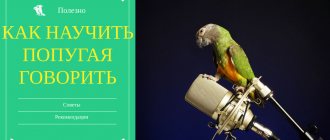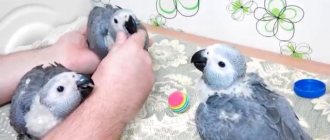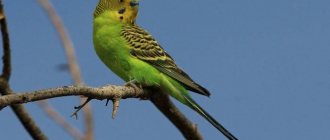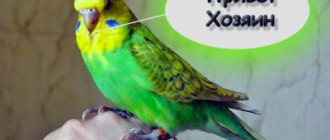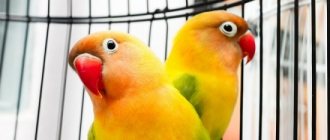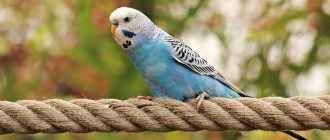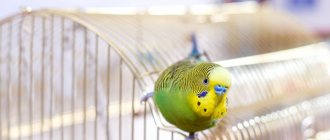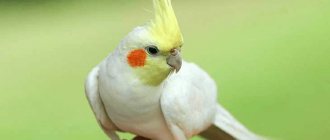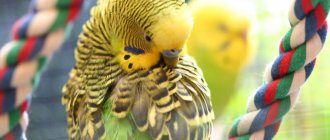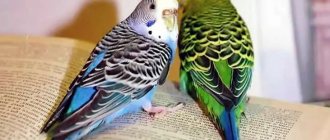- home
- Parrot
- FAQ
05/16/2019 The high demand and popularity of budgies as pets is due not only to their attractive appearance, cheerful disposition and unpretentiousness, but also to the ability to teach budgies to talk. The bird itself will not speak. But if the owner pays due attention to the training and patiently works with the feathered pet day after day, the training will bring results.
Can a budgie learn to say words in 1 day of training?
The most easily trained talkers are the Gray and Macaw parrots. Teaching budgerigars to speak is noticeably more difficult. It will take a lot of time and will require patience and diligence from the teacher. The first word spoken by the wavy is preceded by numerous hard trainings.
Training a feathered pet takes on average 3–5 months. At the same time, in order for the parrot to speak, classes with the bird must be regular throughout the entire period of training. This requires a certain discipline and punctuality from the owner.
The exact time when budgerigars begin to speak is impossible to determine. Each bird is unique and inimitable, each has different abilities, and therefore they achieve different levels of success in learning. One wavy learns faster, the other slower. But still, we have not yet encountered any brilliant birds who spoke before 2-3 months of training. Therefore, the answer to the frequent question whether it is possible to teach a wavy to speak in 1 day is a firm “no.”
Time of first results
When purchasing a pet, you should not dream that the bird will immediately move closer and immediately begin chatting in whole phrases. Depending on the pet’s abilities, training lasts for months.
At first, a positive sign will be the fact when your pet listens with curiosity to the person’s voice and intonation. The first results appear after three weeks of training, depending on the intensity of the training and the vocation of the pet.
When do budgies start talking? With irregular training, the bird pronounces the first word after 3-4 months of training , so it is simply impossible to teach your pet to “talk” in 5 minutes or one day. In the first year of life, the pet’s vocabulary is replenished quite quickly and increases with constant training. The bird retains its accumulated vocabulary throughout its life.
Nuances of training
After the bird utters the first word, things will go noticeably faster - an already speaking budgie absorbs new information and remembers new words much more easily than a bird that has not yet made a human sound.
The parrot makes its first progress in training in stages:
- He listens and tries to catch the sound of the word he is learning, pronounced by the owner.
- Opens its beak in an attempt to repeat the word after the owner.
- Responds to a word with a sound vaguely similar to it.
- With each subsequent attempt, the sound produced becomes more and more similar to the word being learned.
The faster a bird goes through these stages of training, the more talented it is. This means that the greater success she will achieve in developing the ability to speak.
It is especially worth noting that you cannot start teaching a parrot to talk immediately after it appears in the house. It is necessary to give him time to adapt to new living conditions. Before you start training your feathered pet, you need to get to know him, win his trust and make friends. On average, all this takes 1–2 weeks. Only when the bird gets comfortable in its new home, and also considers its owner a friend and trusts him completely, can you begin to train it.
Wavy can remember several hundred words. The parrot does not understand their meaning, but it grasps the cause-and-effect relationship, which allows it to use them at the right time. You can teach a budgerigar to speak only through live communication - a recording turned on near the cage will not help.
Training will also be ineffective if the bird has someone to communicate with in its native language, i.e. she lives with a relative. However, this rule does not apply if this relative is speaking. It is not uncommon for a parrot that can already speak to teach its neighbor words from its own vocabulary. But this process is not controlled by the owner, so it is impossible to predict the result of the proximity of speaking and non-speaking parrots.
Where and when to buy
You can buy a bird at a pet store, at a special market, or directly from the breeder.
Each of these methods has both advantages and disadvantages. It is best to buy a pet from a person who has been raising parrots for several years. However, not everyone has this opportunity, so most often they go to a store or market to make a purchase. The pet store has more guarantees regarding the health and origin of the bird, since sanitary checks are required for such sales. However, consultants are not always competent in matters relating to a specific breed and its characteristics.
The likelihood of buying a bird from a breeder increases on the market. Along with simple sellers, there are also specialists who have been raising birds for years. Also at the market there is almost always an opportunity to see the parents of the chicks. However, during the cold season, an open market is not the best place to sell birds. Parrots are very sensitive to temperatures and drafts. If the bird gets sick, it will require long-term treatment and there is a high probability of death.
It will be much easier to teach a parrot to speak if he gets comfortable in your house and trusts you
The best time to purchase is the end of summer. By this time, the chicks are already strong enough to move into independent “nests”.
At what age should a budgie be taught to talk?
Young budgies learn more successfully than their adult counterparts. Young animals remember new words faster and demonstrate more accurate pronunciation. Therefore, if you want to teach your feathered pet to talk, it is recommended not to delay the start of training.
The optimal period for the development of speaking abilities in a wavy bird covers several months. It is counted from the 35th day from the moment the bird begins independent life (i.e. leaving the parental nest) and continues until the age of six months. The learning ability of a six-month-old parrot is reduced. To achieve results, both the parrot and his owner-teacher will have to put in much more effort. Each word will need to be repeated many times, which will take much more time.
The earlier the lessons begin, the more effective they will be. Therefore, it is advisable to start training your parrot immediately after its adaptation.
Feather imitators
Based on numerous films and cartoons, as well as historical facts, you can verify that budgies actively talk to their owners.
Although, to be more precise, the term “talking” is not correct. In fact, birds only reproduce the sounds that humans make, that is, they become imitators.
Since a feathered pet does not have human thinking, it cannot conduct a conscious dialogue or answer a specific question. But teaching him some words related to the situation is quite possible. Budgerigars are quite smart birds that can string several words into a sentence and even recite a poem, and the quality of pronunciation will be at a decent level.
How does a parrot's gender affect its ability to speak?
It is a proven fact that it is easier to teach a male wavy to talk than a female wavy. The average training time applies mainly to male parrots. With feathered girls everything is much more complicated. Teaching them to speak is very difficult - maximum patience will be required from the owner-teacher.
The results of training a girl parrot appear later than those of a feathered boy. But the effort and time spent training the female is worth it. Wavy beauties have one advantage over boy parrots in their ability to speak. A female parrot speaks much more clearly and pronounces learned words more accurately than most males. And this is despite the fact that parrots of both sexes have the same sound apparatus - both boys and girls lack vocal cords.
Essentially, parrots are ventriloquists. The sounds they make come from the lower part of the larynx, thanks to which budgerigars can talk even with their beak closed. In the area of the bird's chest there is a kind of chamber with external vocal membranes.
Hearing a human conversation between budgerigars is a great success and success, and even more so to communicate with a feathered girl.
Valuable tips - how to quickly train a wavy
Following the recommendations below will teach your bird to imitate a human voice.
Thus, good results can be achieved by rewarding each success of the bird with a treat. For a correctly pronounced sound or word, you should reward the parrot with fruit or something that he likes.
In addition, many parrot owners are interested in the question of how to train their pets in pairs. It should be noted that having a pair, the parrot may pay less attention to the owner, which will negatively affect learning. However, a parrot that is already talking can teach another bird to imitate sounds.
Thus, if there is a task to teach two young birds to talk, then this must be done separately. If one parrot can already talk, then pairing another bird with it will only contribute to its speedy learning.
Six tips to follow when learning to speak
When starting to train a bird, it is important to remember that she does not realize what the words she is learning mean, but simply remembers and repeats the sounds after the person, often linking them in her mind to certain events and situations.
In order for the training to be as effective as possible, certain rules should be followed:
- Meet and make friends with a feathered pet. By the time training begins, the bird must not only be adapted to new living conditions, but also tamed. The parrot must trust the owner and be open to contact. Training will only bring results if the bird does not see danger in its teacher. Otherwise, she will not only not listen, but every lesson will become stressful for her. Of course, nothing good will come from such training.
- Choose the first word to learn. It is advisable that this word be the name of the parrot - this way the owner teaches the bird both to talk and to respond to its name. Regardless of which word is chosen, it must be pronounced often and in its entirety. If the bird cannot repeat the word completely, you need to break it down into individual sounds and teach it in parts.
- Maintain eye contact and pronounce the word correctly. It is very important during training to look directly at the bird, or rather, into its eyes. This will let the bird know that the owner’s speech is addressed specifically to it.
- Give the bird time to react to the word. There is no need to continuously repeat the same word. It is important to present it in the form of an address to the bird, while giving the pet a little time to react to what it hears.
- Conduct lessons daily. The recommended duration of each is 5–20 minutes at the beginning of classes and 30–40 minutes later. The duration must be adjusted according to the student’s mood. It is advisable to conduct lessons at the same hours and, if possible, twice a day. It is very important to stick to your schedule and not miss classes.
- Praise your parrot and reward him with treats, even if he has not yet achieved significant learning victories.
During the lesson, both the teacher and the feathered student should be in a good mood. You should not disturb the bird with training when it is playing, or wants to sleep or eat.
Learning to teach
Since the training method does not differentiate between the sex of the pet, the first steps to imitating human speech are equally suitable for both males and females. After getting used to the bird, it is necessary to establish an emotional connection. The next steps will be:
- After the lesson, pamper your pet with some treat. Word choice. This could be a pet's name, or a short word consisting of two syllables.
- It is advisable to pronounce the word while looking at your pet so that he realizes that the speech is addressed to him.
- The word is pronounced clearly, modulating with sounds. Intonation is maintained throughout all classes. If the pet is not interested, then the word is replaced.
- Throughout the training, after each pronunciation, the parrot must be given a pause to understand the word.
- The first result is a response in the form of a simple sound. Over time, the pet will begin to produce only the outline of the word and after 2-3 months will pronounce it in its entirety.
- Classes are held daily, for 10-20 minutes. The amount of time is adjusted depending on the mood of the pet.
- Efforts are rewarded with treats.
To avoid funny moments, it is advisable not to utter swear words.
After the first word learned, they begin to memorize the next one, simultaneously creating a combination of word and action, that is, when turning to the pet, accompany the new word with movement. For example, upon entering an apartment, the owner says a greeting. The bird will understand that the word is associated with appearance and vice versa, the word farewell means leaving.
If you create associations with food, the parrot will soon understand that the food shown is associated with feeding. For example, if you show an apple and pronounce the word “eat”, then over time the pet will begin to clearly pronounce what he would like to treat himself to. With each new word learned, the food or fruit is changed to the next one.
Gradually, depending on the result, the words are complicated from simple to multi-syllabic. When learning at a fast pace, individual words are changed into phrases or short poems. The owner's actions are correct if the bird exhibits the following behavior:
- During training, he looks carefully, fluffing his wings and closing his eyes.
- Biting her lips during long pauses.
- Shows initiative by flying up to the owner, sitting on a finger or shoulder.
- Pronounces new sound combinations.
If the owner is not satisfied with the quality of imitation, then he should pronounce the sounds more clearly; perhaps it is due to poor diction. Also, your pet's muttering means that the learning process is at an intermediate stage. In this case, classes continue and are not interrupted.
How to teach an adult budgie to talk?
You can teach a wavy to talk at any stage of the bird's life. But the older the feathered student, the more difficult science will be for him, and accordingly, the more effort the owner will have to make to teach him. Adult wavy fish take much longer to learn to speak than their young relatives.
It is better to abandon the idea of teaching an adult female to speak altogether. Even at a young age, parrots study longer than their male relatives. You will have to spend too much time on an adult female. Besides, there is no guarantee that she will eventually speak.
It is better to start training male parrots. Even when working with adult males, achieving the desired result is not so long and problematic. Adult parrots should be trained following standard rules - they apply not only to young birds, but to parrots of all ages. With due diligence, the result will not take long to arrive and soon you will be able to hear an adult budgerigar talking.
How to teach a budgie to pronounce sounds clearly?
Birds, like people, have different capabilities and abilities. One bird can speak like an announcer, another can barely put sounds into words, and the third cannot speak at all.
You should not demand perfect pronunciation from the wavy from the very first training. Just as you shouldn’t think that a feathered pet is lazy and doesn’t try. Perhaps he is already speaking, using the maximum of the abilities given to him by nature. Or maybe he just needs more training.
In any case, you should continue studying. At each subsequent training, the parrot will improve and hone its pronunciation. If only the bird is able to speak more clearly, in time it will certainly do so.
Important information regarding training
When purchasing a parrot, those who want to teach their pet to speak should choose birds that are calm, curious, and interested in everything around them. Such birds easily become interested in human speech, and this is the first step to successful learning. In addition, the bird, of course, must be vigorous and healthy.
Before starting the lesson, it is worth taking out the toys and mirror from the cage. Otherwise, the bird will be constantly distracted from its activities by entertainment. But, of course, after training, the bird’s playing accessories must be returned to the cage. It is worth noting that a mirror can interfere with a bird’s learning, since it perceives the reflection as a fellow bird, and, accordingly, will strive to communicate with it in its native language.
When conducting lessons in a room with a bird, there should be no distractions - other people, animals, the TV on, etc. There should only be two people in the room - a teacher and a student, i.e. owner and parrot. The environment should be as calm as possible.
You need to speak not quickly, not loudly and not sharply, but at the same time emotionally. Inexpressive speech will not attract the bird’s attention, and too harsh intonations will frighten the bird. You also cannot move quickly, gesticulate, etc. – in such an environment the bird will be scared and uncomfortable. Goodwill should be felt in the voice. When learning one word, you cannot change the tone of pronunciation from lesson to lesson, as this can confuse the bird.
Common mistakes
A voice recorder will only do harm during the learning process. Common mistakes in training budgies include:
- Frequent use of voice recording.
- The use of ill-conceived phrases or phrases.
- Application of specific terms.
- Frequent changes in intonation, tone or rhythm.
The gravest mistake is to use harshness, violence or intolerance. You should not raise your voice at the bird, scare it with sudden movements, or try to grab it with your hand.
